Preserving Its Original Form through Scientific Conservation Treatment – Our Conservation Efforts over the Past 5 Years –
LEE Taejong
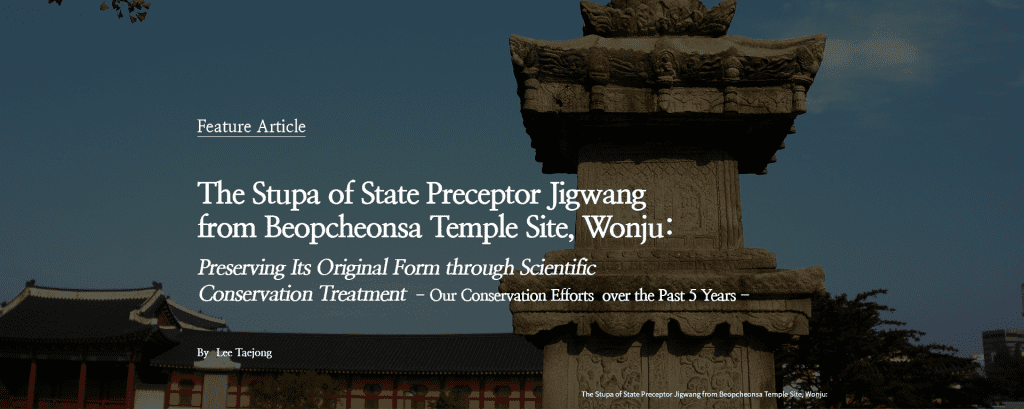

The conservation treatment for the Stupa of State Preceptor Jigwang was conducted only after all scientific and technical means required for its study and protection were secured. Since the treatment aimed to conserve the stupa’s aesthetic and historical value and was based on an understanding of its original form and materials, the restoration decisions were made with careful moderation. As a result, the restoration work, which started with the dismantlement of the stupa in March 2016, has been successfully completed, thereby preserving its original form and restoring its authenticity.Erecting a Stupa for Monk Haerin, the State PreceptorThe Stupa of State Preceptor Jigwang from Beopcheonsa Temple Site, Wonju (National Treasure No. 101) is a stupa enshrining the sarira (relics) of Monk Haerin (984–1070) who served as a state preceptor during the reign of King Munjong, the 11th ruler of the Goryeo dynasty (918–1392). His ancestral town was located in Wonju, and he served as a royal preceptor and state preceptor in the capital city of Kaesong, before returning to Beopcheonsa Temple in Wonju, where he passed away in 1070. Later, he was granted the posthumous name Jigwang, and in 1085, a stupa enshrining his relics and a stele inscribed with a eulogy for him were erected. The stupa, in particular, is considered a gem, showcasing the sculptural beauty of Goryeo art because, even though the entire stupa is adorned with diverse designs and unique ornamental elements, they are neatly arranged in an elegant manner. In 1962, the stupa was designated a National Treasure.
Relocation of the State Preceptor’s Stupa


The stupa, which had stood for a millennium at the Beopcheonsa Temple Site, was relocated from Wonju to Seoul during the Japanese colonial period as it was sold to a Japanese collector in 1911. In Seoul, it shifted around from a Japanese-owned hospital in downtown Seoul to the garden of a private mansion, before being transported to Japan in the spring of 1912. However, the Japanese Government General of Korea raised an issue about the relocation of the stupa overseas and had it returned to Korea in the autumn of the same year. Nevertheless, the returned stupa was reduced to a mere exhibit at the Joseon Industrial Exhibition, an event held to provide justification for Japanese colonial rule. With this turn of events, the stupa came to stand within Gyeongbokgung Palace, its present location.
As confirmed thus far, the artifact has experienced dismantling and relocation approximately ten times. Presumably, in the meantime, some elements were broken or damaged. Indeed, during the Korean War (1950–1953), after aerial bombing, the top portion of the stupa was shattered into some ten thousand pieces. External impacts have also left cracks, both large and small, inside the stupa.


Diagnosing the Millennium: In Remembrance of Korean War WoundsEven though the stone stupa was severely damaged by bombing during the Korean War, it was restored in 1957 to its present form, thanks to Master Im Cheon (1908–1965) who pioneered the repair and restoration of cultural heritage properties in Korea. Elements that had been completely destroyed were restored by applying highly advanced methods, where metal brackets, rough surfaced steel bars that enabled maximum bonding with concrete and other materials were utilized to hold broken pieces together before gluing them together permanently with lead and cement. At the same time, missing parts (4.6% of the total volume) were restored using mortar. In particular, onethird of the upper elements that had been directly hit by a bomb, including okgaeseok (roof stone) (47%), anghwa (lotus flower design in the finial) (37%), and bogae (cap covering a vertical series of decorative disks known as boryun) (35%) were restored using mortar. However, over the course of the past 60 years, the neutralization of mortar at a depth of around 3 cm has created reaction products, which, in turn, resulted in physical and chemical damage to the stupa.
In response, to identify the type and location of each instance of damage, researchers created a map containing details of the physical, chemical, and biological damage while also analyzing the properties of the stone using an ultrasonic device. Since it was difficult to visually identify the existence and scope of peeling on the ornately decorated surface, an infrared thermal imaging device was utilized as well.
The examination revealed that the stupa’s top portion and roof stone had undergone the highest percentage of mortar restoration and that the stupa was broken away and peeled in several spots. Also identified were traces of restoration using some 100 steel bars, dozens of brackets, and anchor bolts, as well as the fact that steel bars placed at an average depth of 38 mm suffered from a high level of corrosion.
As for the body of the stupa, a large amount of surface peeling was identified on the eastern (41.5%) and southern (12.4%) sides, a phenomenon mainly caused by salt-induced weathering due to the Calcium and Sulfur oxides within mortar. These materials also caused white and black discoloration. In particular, the black discoloration in foundation stones in the upper and lower sections of the stupa are products of secondary discoloration resulting from the combination of air pollutants and black carbon included in fine particles.
As for the foundation section of the stupa, severe structural deformation (e.g. the separation of diverse structural elements) was identified. Most elements of the stupa were classified as suffering from mid-level (level 3) weathering. Among the elements examined, jidaeseok (ground stone sitting at the lowest part of the foundation) turned out to be particularly vulnerable, experiencing advanced-level (level 4) damage.
Several instances of dismantling, relocation, and restoration caused the stupa to lose much of its original form, with the use of mortar aggravating and accelerating its weathering caused by secondary pollutants and deposits. To cope with this problem, the National Research Institute of Cultural Heritage (NRICH) was enlisted to undertake the conservation treatment process for this precious cultural heritage.
Stupa on the Operating Table: Conserving Its Original FormThe stupa was dismantled in March 2016, and its conservation treatment began in May of the same year. Thus far, a wide range of intervention measures (e.g. recording details on disassembled elements, the removal of pollutants, the gluing of broken parts, and the restoration of missing elements using new stone) have been taken to best sustain the value of the cultural heritage embodied by the stupa.
In general, the methods, techniques, and materials used for conservation treatment depend on diverse factors related to the specific stone artifact, including the material attributes, current state of conservation, conservation environment, and location of final placement after treatment. As such, there are no firmly established guidelines or principles concerning such details. Against this backdrop, after the stupa’s value, meaning, and significance were clearly recognized, the conservation treatment proceeded, based on scientific data and experience-backed expertise.
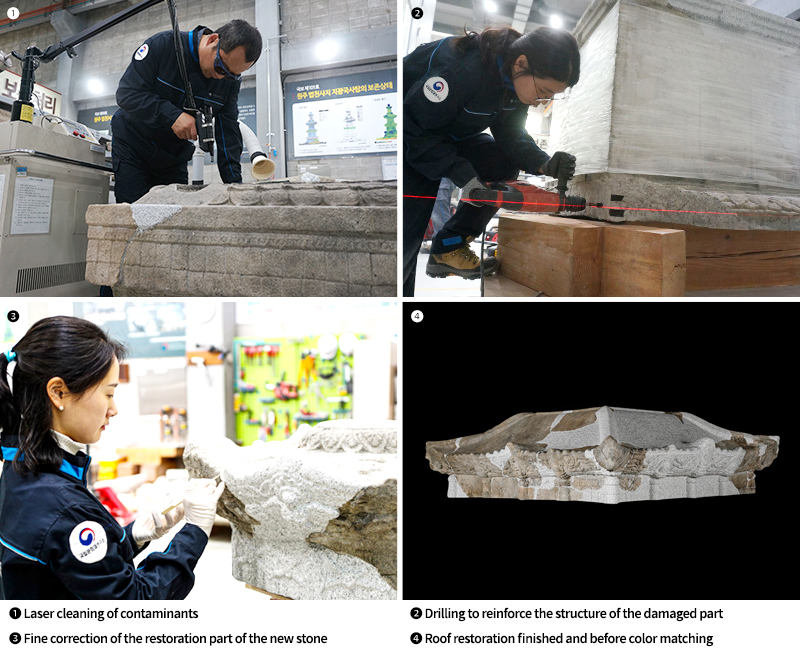

Removal of PollutantsAs a way of removing black pollutants covering the entire stupa, a laser cleaning method was suggested. Yet, this method had its limitations. The monochromatic characteristic of laser emissions allows for the selective removal of pollutants, but, for the same reason, this method is not considered applicable to rocks containing minerals of different colors. However, since the pollutants on the stupa were in the form of crust and since they were not supposed to be fully removed, our experts were able to eliminate the pollutants with minimal damage to the stone. Specifically, the surface layer of black pollutants was first removed using dry and wet cleaning methods, as well as by hand by utilizing scalpels, before two types of lasers (Nd:YAG and Yb:fiber lasers) were used for cleaning.
Removal of Mortar Used in Previous RestorationUsually for stone stupa restorations, the mortar used in previous restoration works are mostly removed, in consideration of diverse factors (e.g. the heterogeneity of materials, the secondary weathering of constituent stones due to the weathering of mortar, and the restoration principle recommending the use of identical stone materials). However, in this case, 47% of the total volume of the okgaeseok (roof stone) was previously restored using mortar, and its removal would have made it impossible to maintain the element’s original form whilst directly affecting its structural functioning. As such, the decision to remove the mortar was made after careful deliberation. As for the actual process, to ensure the conservation of the artifact’s original form and the restoration of its authenticity, the half-cell potential (HCP) method was used to noninvasively measure the degree of corrosion found in the steel bars used in the portions restored with mortar. At the same time, a correlation analysis was conducted to evaluate the scope of mortar damage and to provide engineering data proving the necessity of mortar removal. By analyzing reaction products, stone deterioration mechanism caused by the mortar could be interpreted, thereby securing a rationale for the removal of previously restored portions.
The actual removal of the mortar involved the use of both traditional methods and contemporary tools. In parts where severe damage or breakage could be expected, the removal was conducted with moderation. Similarly, when necessary, the parts were temporarily reinforced using cyclododecane before removal work began.
Gluing of Broken ElementsGluing is an important process in the conservation treatment of stone artifacts. In this case, patent-based scientific data, as well as glues optimized for joining together domestic stone artifacts were used. When reinforcing the structure of joints, the material attributes of relevant stupa parts were first identified and the cross-sectional area of the joints calculated, followed by the determination of diverse elements, such as the diameter of reinforcing metal products (e.g. fully threaded titanium rods), stable sheath thickness, and the length & depth of holes. Afterwards, reinforcement positions were marked on joint surfaces, remaining pollutants were removed, and then mineral particles on joint surfaces in the process of peeling and granular decomposition were completely eliminated to enhance bond strength.
Restoration of Missing Elements Using New StoneSince some elements, such as okgaeseok (roof stone) and anghwa (lotus flower design in the finial), would not have been able to sustain their forms with the mortar removed from them, our experts decided to first remove mortar from these elements, and then restore them using new stone. Regarding this task, we wish to inform our readers that there are still ongoing concerns about how to guarantee proper conservation of the original form of the remaining original elements while ensuring the authenticity of portions restored with new stone.
Selection of New StoneTo obtain new stone needed for restoration, various sites were examined, including five outcrops near the Beopcheonsa Temple Site in Wonju; two former quarries, where stone similar to that used for the stupa could be found; and eight currently operating quarries. This investigation focused not only on finding the origin of the stupa’s stone but also on determining the feasibility of excavation and of securing sufficient quantities of such stone. As a result, in consideration of similar petrographic characteristics, mineralogical composition, and geochemical attributes, Wonju Stone was selected as the restoration material. After this decision, only stones that passed quality tests (e.g. in terms of compressive strength, water absorption rate, and density) conducted by an authorized agency were used for the restoration work.
Restoration of Design Elements on New StoneThe first phase of creating new stone parts was to restore missing motifs and designs in a historically accurate way. Stone stupas are characterized by ornate sculptural elements and symbolic decorations. For this reason, while restoring the stupa using new stone, our experts strived to restore It to its original form. Specifically, by analyzing Buddhist sutras, they sought to understand the Buddhist tradition of Beopcheonsa Temple, a monastery belonging to the Beopsang (Dharmalaksana) School of Buddhism. They also reviewed photographic plates of the stupa, which were created through three distinct photographing sessions (in 1911, 1923, and 1932) during the Japanese colonial period, and examined survey drawings from 1934. Thanks to such efforts, missing designs were restored close to their original form.
Shaping New Stones and Restoring Sculptural ElementsBased on the sculptural information obtained from 3D scanning and 3D printing, plaster models were created to facilitate the shaping of new stones. Except for the quarrying process that utilized diamond wire saws, the processing and sculpturing of new stone was conducted using traditional stonemasonry techniques, in the order of cutting stone, shaping it with an iron hammer, rough chiseling, and fine chiseling. This process was followed by detailed processing and sculpturing.
The primary processing involved the cutting and processing of new stone pieces at 110–130% of the desired sizes, based on 3D plaster models. Next, the joint surfaces of newly carved pieces were refined to ensure a perfect fit with the original, remaining elements of the stupa. These new stone pieces were then temporarily attached to the original elements and, as part of tertiary processing, were reduced to their intended sizes.
Once the processing work was completed, sculpturing work was conducted in three phases: the first phase for creating an overall shape, the second for carving detailed forms and designs, and the third for adding the minutest details (such as a smile and the subtle curve of an eye). All sculptural work was conducted by our team and a master stonemason, who is also designated as a holder of Important Intangible Cultural Heritage, using traditional tools and techniques. These tools and techniques were also recorded in detail and further developed into resources.
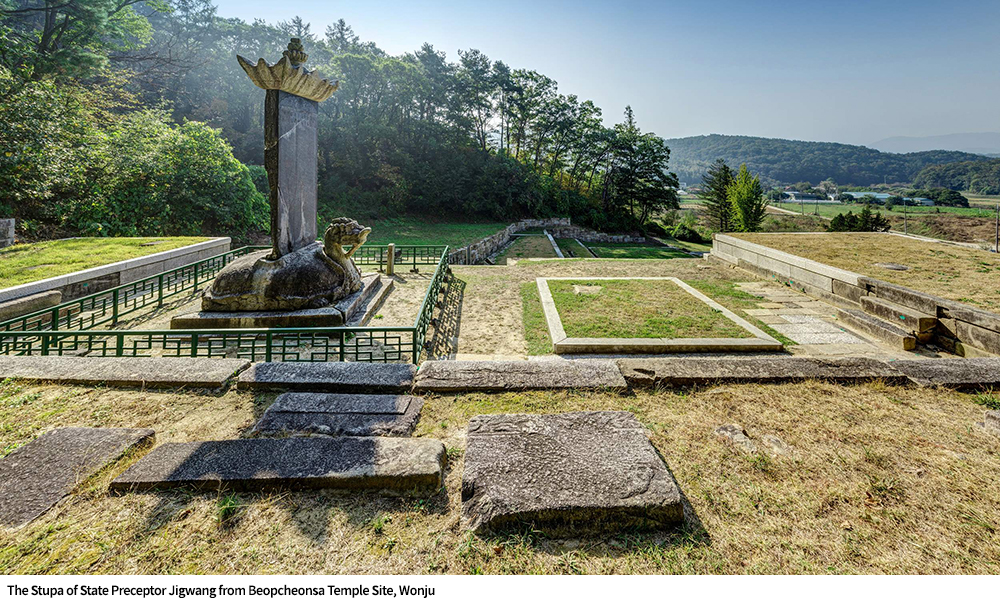

Issues Concerning the Conservation of the Stupa’s Original FormEven though the meaning of an “original form” may refer to the first appearance of a cultural heritage item, or how it looked when it was initially created, it is imperative that the concept include traces of history, especially when associated with cultural heritage that has survived the test of time. As such, it follows that the original form of the stupa may naturally include traces of repair work performed in 1957. The authenticity of a cultural heritage property refers to its distinctive characteristics judged from diverse aspects, and therefore the number of criteria it satisfies determines the property’s value and status. In this regard, although authenticity is the most ideal notion of conservation, it is nevertheless an ambiguous concept when it comes to the conservation of the original form, as it is torn between the emphasis on an “initial form” and the one embracing “vestiges of time.” This conundrum is addressed thoroughly in the Nara Document on Authenticity adopted in 1994, which contains varied interpretations of the authenticity of cultural heritage, in terms of form and design, materials and substance, use and function, traditions and techniques, and other internal and external factors.
In line with such international standards, our conservation treatment of the stupa has ensured that the 60-year historicity associated with the most restoration conducted by the National Museum of Korea in the past are preserved as distinctly separated, as the limitations of materials used in the previous restoration and causes of acceleration in the weathering of original stupa elements were scientifically determined. At the same time, our experts succeeded in restoring the stupa to its pre-restoration form dating back to 1911 and before, based on photographic plates and survey drawings. Furthermore, new restoration materials were selected based on relevant experiments and findings in academic papers. By utilizing outstanding patented modern conservation technologies, our team proactively conducted conservation treatment based on scientific data.
The conservation treatment of the stupa was conducted only after all scientific and technical means required for Its study and protection were secured. Since the treatment aimed to preserve the stupa’s aesthetic and historical value and was based on an understanding of the original form and material, the restoration decisions were made with careful moderation, thereby contributing greatly to the conservation of the original form and the restoration of authenticity.

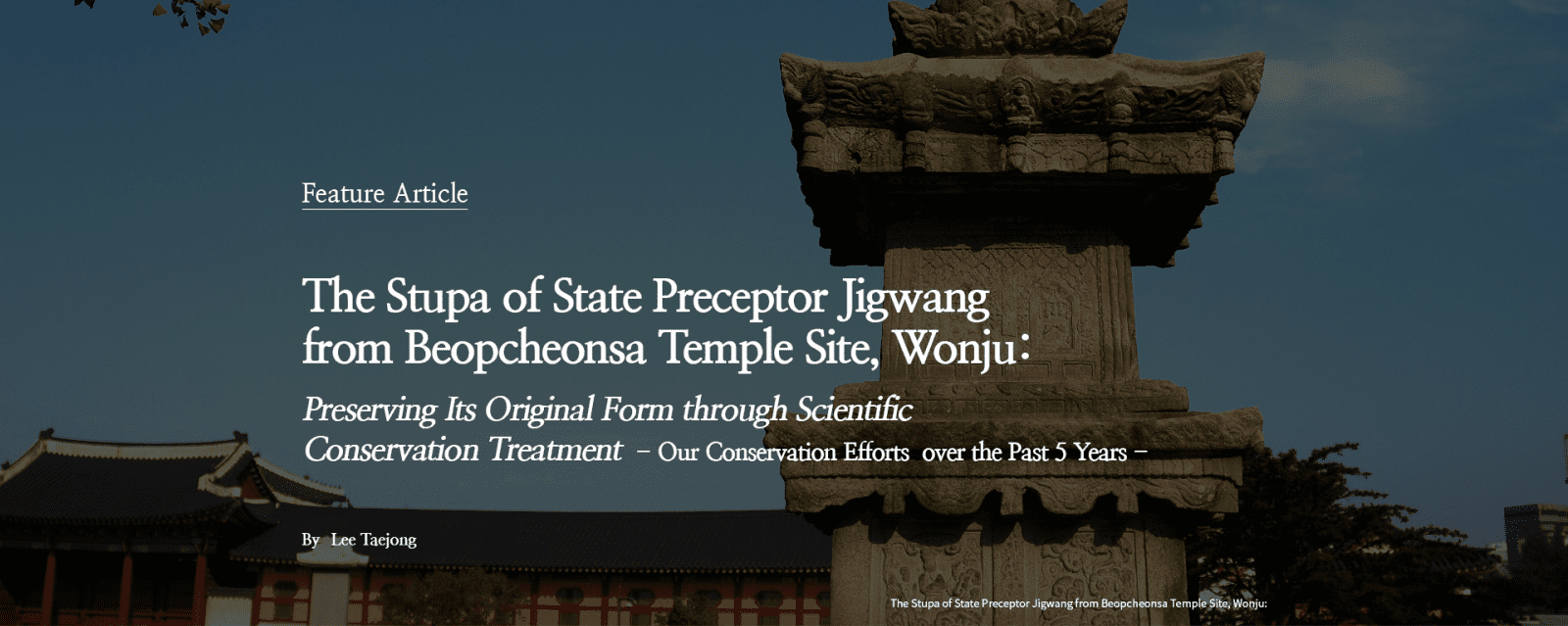
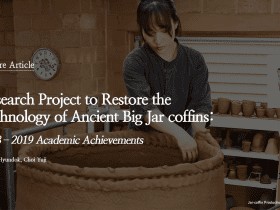
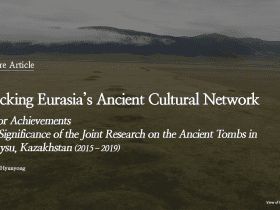
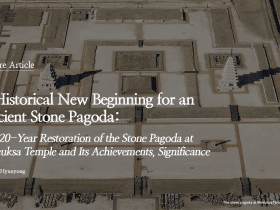
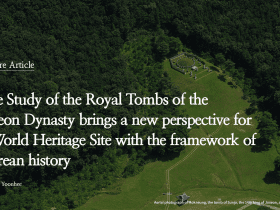
Leave a Reply